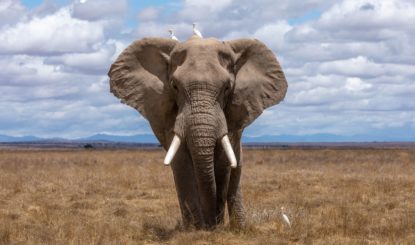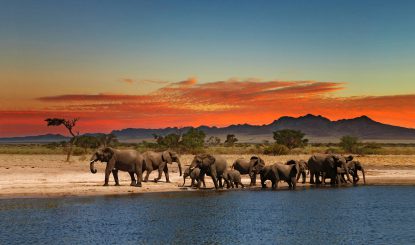Namibia’s desert elephant populations are on the verge of extinction
Namibia’s famed desert elephants are acutely threatened with extinction. The main reason for this is trophy hunting. This is compounded by drought and mismanagement of conservation both at local and government level.
In the vast 115,000 square kilometre Kunene Region in the dry north-west area of Namibia, lives a population of remarkable desert-adapted elephants, the only elephants of their kind in sub-Saharan Africa. This is an area of mostly sandy and stony plains and rocky mountains where small human groups of nomadic rural communities and some commercial livestock farmers co-exist with them. Namibia’s desert elephants have traditionally lived in this area for millennia and in the earlier part of the 20th century there were about 3,000 elephants roaming the Kunene Region. However, by the 1980s, these had greatly diminished in number to around 300, largely as a result of poaching for their tusks and over-hunting by the South African Defence Force which was operational in the area during the 1970s and 80s.
Since then, conservation measures with rural communities were put in place in order to save the elephants and other desert-adapted wildlife. Soon after independence in 1990, the Namibian government extended regulated wildlife use rights to the rural communities in the Kunene Region who formed management units called ‘community-based conservancies’. As a result, by 2013 the number of elephants had increased to about 600 individuals.
The problem of trophy hunting elephants
Unfortunately, during the last decade, the desert-elephants are once again under threat. The community-based conservancy model, which had initially helped with the small recovery of the elephant population in the Kunene Region, is now the main cause of their decline.
The original intention of the community-based conservation model was to both conserve wildlife and to rectify the unequal status of Namibia’s marginalised rural poor. In order for impoverished communities to derive financial benefits for Kunene’s two dozen or so communal-area conservancies, elephants are often shot by international trophy hunters who pay up to 50,000 Swiss francs to do so.
The hunting of big game species is a lucrative business in Namibia where a quota of up to 90 elephants nationwide may be shot as trophies. Trophy hunting is hailed as a success story and is often regarded as a ‘necessary evil’, required in order to make nature’s economic value viable so that wildlife populations and habitats may be conserved. Nature, according to the Namibia government, must be profitable, and stakeholders at all scales (whether local communities or international safari operators) must see returns on their investments if species such as elephants are to stay.
Main conflict: water installations
Trophy hunting is also justified in order to reduce human-elephant conflict. In the arid Kunene Region, elephants often target and destroy water installations that supply entire villagers with their drinking water. Elephants, usually lone males, are often those that repeatedly do this and are therefore targeted exclusively by trophy hunters. In the absence of a paying client, elephants are shot by a government-appointed official if they are deemed to repeatedly destroy water installations.
Trophy hunting threatens population
Unfortunately, the practice of trophy hunting has seen Kunene’s already fragile elephant population crash. In 2016, only 277 elephants were counted during an aerial survey of the region. The most worrying aspect of that count was the ratio of male to female elephants – just 22 males were counted of the 277, a figure of less than 10%. The lack of breeding males will have a major impact on the stability and strength this isolated population. Without males, very few new elephants are born. This combined with a severe drought that has been prevalent during the last five years means far more elephants are dying than being born.
A study by Elephant-Human Relations Aid (EHRA) in 2020 has shown this alarming trend continue. In the south of the Kunene Region along the Ugab River there are extremely low numbers of adult cows and even less adult bulls. Since 2017, three adult bulls in their prime breeding age were shot, two of which were destroyed as problem animals and one as a trophy. Another young male of 19 years was shot as a problem-causing animal. Only one breeding male remains in the southern Kunene area. The lack of breeding bulls, therefore, remains a major concern for the overall health of the desert elephant population.
Drought
Due to the drought and human-induced stress, calf mortality in the southern part of the Kunene region stands at a staggering 100%. This means no new elephants have been added to the population since 2014. Information from local farmers, community members and biologists are suggesting that the overall population may now be less than 200 elephants.
Little financial benefit
Furthermore, recent field research by this writer has shown that the communities within the conservancies who rely on financial benefits from trophy hunting of elephants are receiving very little, or no financial income from trophy hunting. Typically, about 20% of the overall fee paid by a trophy hunter will go to the conservancy management. In Kunene, conservancy managements are supposed to use those funds either as direct payments or to assist the financing of schools and clinics, for example. However, in most cases the funds disappear into the hands of a few corrupt officials.
In the commercial farming areas outside of the conservancies, the desert elephants fare even worse. Farmers actively persecute elephants for destroying fences and water installations. Again, as lone bulls are usually the perpetrators, they are the ones targeted most, which reinforces the fact that so few male elephants exist.
Live elephant sales
To make matters worse, the Namibian government announced last year that it would capture and remove about 80 elephants that roam the commercial farming areas of the Kunene Region. Their plan is to sell around six family groups and twelve individual males to national and international clients and make a hefty profit from it. Live elephants typically sell for around 20,000 to 30,000 Swiss francs.
Removing 80 elephants from a population already suffering drastic losses will cause the extinction of Namibia’s last remaining desert elephants. This must be prevented!
| Desert-adapted elephants Desert elephants are different to other African elephants in many ways, although they are genetically not regarded as a distinct species. They have developed certain adaptations for desert life and tend to have relatively broader feet, longer legs and smaller bodies than other African elephants. Their diet varies with the time of year moving between the mountains and the sandy plains depending on the season and availability of food and water. They are able to walk up to 70 kilometres at night to find water points, which is the cause of their bigger feet and longer legs. In the wet season, they prefer buds and fresh green leaves but in the dry season they subsist on drought-tolerant plants such as camelthorn trees, myrrh bushes, mopane and ana trees. Unlike most other elephants these unique desert-dwelling elephants can go without water for up to three days at a time. The family groups are small and usually consist of a dominant female elephant, or matriarch, and her offspring or two sisters and their dependent young. Fully-grown male elephants are usually solitary and roam greater distances. They all tend to stay near the dry river beds where there is greater availability of food. |
More information:
- Our project page «Elephant protection»
- Our project page «Ivory Trade»

